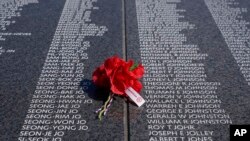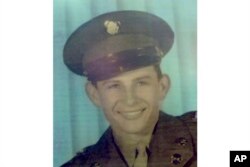Soldiers of the 9th Infantry Regiment made a desperate retreat as North Korean troops closed in around them. A wounded, 18-year-old Army Pfc. Luther Herschel Story feared his injuries would slow down his company, so he stayed behind to cover their withdrawal.
Story’s actions in the Korean War on September 1, 1950, would ensure he was remembered. He was awarded the Medal of Honor, the nation's highest military honor, which is now displayed alongside his portrait at the National Infantry Museum, an hour’s drive from his hometown of Americus, Georgia.
But Story was never seen alive again, and his resting place long remained a mystery.
“In my family, we always believed that he would never be found,” said Judy Wade, Story’s niece and closest surviving relative.
That changed in April when the U.S. military revealed lab tests had matched DNA from Wade and her late mother to bones of an unidentified American soldier recovered from Korea in October 1950. The remains belonged to Story, a case agent told Wade over the phone. After nearly 73 years, he was coming home.
A Memorial Day burial with military honors took place Monday at the Andersonville National Cemetery. A police escort with flashing lights escorted Story's casket through the streets of nearby Americus on Wednesday after it arrived in Georgia. Then residents lined the streets Monday as the funeral procession drove by, WALB-TV reported.
“I don’t have to worry about him anymore,” said Wade, who was born four years after her uncle went missing overseas. “I’m just glad he’s home.”
Among those celebrating Story’s return was former President Jimmy Carter. When Story was a young boy, according to Wade, his family lived and worked in Plains on land owned by Carter's father, James Earl Carter Sr.
Jimmy Carter, 98, has been under hospice care at his home in Plains since February. Jill Stuckey, superintendent of the Jimmy Carter National Historical Park, said she shared the news about Story with Carter as soon as she heard it.
“Oh, there was a big smile on his face," Stuckey said. "He was very excited to know that a hero was coming home.”
Story grew up about 150 miles (241 kilometers) south of Atlanta in Sumter County, where his father was a sharecropper. As a young boy, Story, who had a keen sense of humor and liked baseball, joined his parents and older siblings in the fields to help harvest cotton. The work was hard, and it didn't pay much.
“Momma talked about eating sweet potatoes three times a day,” said Wade, whose mother, Gwendolyn Story Chambliss, was Luther Story's older sister. “She used to talk about how at night her fingers would be bleeding from picking cotton out of the bolls. Everybody in the family had to do it for them to exist.”
The family eventually moved to Americus, the county's largest city, where Story's parents found better work. He enrolled in high school, but soon set his sights on joining the military in the years following World War II.
In 1948, his mother agreed to sign papers allowing Story to enlist in the Army. She listed his birthdate as July 20, 1931. But Wade said she later obtained a copy of her uncle's birth certificate that showed he was born in 1932 — which would have made him just 16 when he joined.
Story left school during his sophomore year. In the summer of 1950, he deployed with Company A of the 1st Battalion, 9th Infantry Regiment to Korea around the time the war began.
On September 1, 1950, near the village of Agok on the Naktong River, Story's unit came under attack by three divisions of North Korean troops that moved to surround the Americans and cut off their escape.
Story seized a machine gun and fired on enemy soldiers crossing the river, killing or wounding about 100, according to his Medal of Honor citation. As his company commander ordered a retreat, Story rushed into a road and threw grenades into an approaching truck carrying North Korean troops and ammunition. Despite being wounded, he continued fighting.
“Realizing that his wounds would hamper his comrades, he refused to retire to the next position but remained to cover the company’s withdrawal,” Story's award citation said.
“When last seen he was firing every weapon available and fighting off another hostile assault.”
Story was presumed dead. He would have been 18 years old, according to the birth certificate Wade obtained.
In 1951, his father received Story's Medal of Honor at a Pentagon ceremony. Story was also posthumously promoted to corporal.
About a month after Story went missing in Korea, the U.S. military recovered a body in the area where he was last seen fighting. The unidentified remains were buried with other unknown service members at the National Memorial Cemetery of the Pacific in Hawaii.
According to the Defense POW/MIA Accounting Agency, more than 7,500 Americans who served in the Korean War remain missing or their remains have not been identified. That's roughly 20% of the nearly 37,000 U.S. service members who died in the war.
Remains of the unknown soldier recovered near Agok were disinterred in 2021 as part of a broader military effort to determine the identities of several hundred Americans who died in the war. Eventually scientists compared DNA from the bones with samples submitted by Wade and her mother before she died in 2017. They made a successful match.
President Joe Biden announced the breakthrough April 26 in Washington, joined by South Korean President Yoon Suk Yeol.
“Today, we can return him to his family," Biden said of Story, "and to his rest.”










